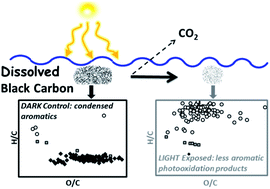Insights into the complete and partial photooxidation of black carbon in surface waters†
Abstract
Increasing wildfire activity in the Alaskan Arctic may result in new sources of black carbon (BC) to arctic watersheds. Black carbon, primarily comprised of condensed aromatics, is one of the most chemically recalcitrant fractions of organic carbon. However, lateral transfer of particulate and dissolved BC from soils to sunlit surface waters is increasingly suggested to result in the photochemical mineralization of BC to CO2. While sunlight can also partially photooxidize aromatic compounds in surface waters, producing compounds with a higher O/C than the parent compound, this degradation pathway has not yet been identified for either particulate or dissolved BC. To address knowledge gaps on the photochemical degradation of particulate and dissolved BC, we quantified the complete and partial photooxidation of particulate and dissolved BC derived from arctic biomass as photochemical CO2 production and O2 consumption relative to dark controls. Concurrently, we investigated shifts in the chemical composition of dissolved BC following exposure to sunlight using UV-visible absorbance, fluorescence spectroscopy, and Fourier transform ion cyclotron resonance mass spectrometry (FT-ICR MS). The chemical and physical properties of BC produced from charring arctic biomass were similar to BC produced by wildfires in terrestrial ecosystems based on elemental analysis and FT-ICR MS. Based on the concentration of light-absorbing carbon in each fraction, dissolved BC was disproportionately more susceptible to complete and partial photooxidation compared to particulate BC. Upon exposure to sunlight, the predominant fate of dissolved BC was partial photooxidation, while a smaller fraction of dissolved BC was photomineralized to CO2. Shifts in both the optical and mass spectrometry spectra suggested that condensed aromatics likely comprised the fraction of dissolved BC that was completely and partially photooxidized. To further refine the meaning of sunlight as a sink for aquatic BC, the reactivity of partially oxidized photoproducts of BC in the aquatic organic carbon pool must be determined.

- This article is part of the themed collection: Aquatic photochemistry

 Please wait while we load your content...
Please wait while we load your content...